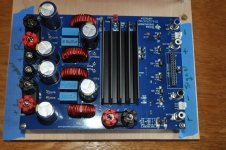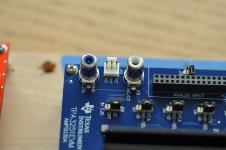The M2 marker shows the crosstalk. This tone is generated at the amplitude of the other tones on the right channel (not shown) and by looking at the amplitude of this tone on the left channel, you can see the crosstalk, which is about -62 dB.
Thanks for the measurements, very informative! I have a follow-up question:
Did your tests show any difference in crosstalk for the 2 power supplies you tested? I am curious whether power supply design affects crosstalk.
Thanks for the measurements, very informative! I have a follow-up question:
Did your tests show any difference in crosstalk for the 2 power supplies you tested? I am curious whether power supply design affects crosstalk.
I'm not sure. I think the setup cabling and layout might have a much bigger impact than the part itself. The part itself is capable of almost -100 dB @1KHz from TI's data (about -75 dB @ 20 KHz). What remains to the teased out of the ~-65 dB figure in the plot is how much is from the power supply, EVM layout and cabling to loads. Next time I resurrect the setup and play around a bit and see if there's much changing from re-routing wires and/or power supply
Will wait for it, for sure
Thats good competition. IFI says it's adapter has only 0.0006 uV of noise.
I didn't quite like the Allo Volt+ amplifier. I found the sound quite lifeless.
Sorry, I must correct the noise figure I typed above. The correct value is 1uV. I took this figure from the IFI 5v advert on Amazon.com.
These are some follow-up measurements on the 3255 EVM that'd I'd previously posted in the "what's wrong with the 3255" thread.
Those measurements were made on a low-noise power supply. The first attachment here shows the comparison between a lab supply and a no-name 48V 480W power switching supply brick from Amazon (search DROK Adjustable DC Power Voltage Converter--it's good for a bit beyond 2x150W continuous into 4 ohms before limiting).
The summary is that whether lab supply or no-name switcher, the output noise is about the same. The lab supply is very close to TI's published spec. The no-name switcher isn't much worse.
The next two plots look at multitone test. Multi-tone lets you look at freq response, crosstalk and THD is a single measurement. Note that into 8 ohms, you'll see at 20 KHz the output is about -0.9dB relative to 1K. Into 4 ohms, you'll see at 20 KHz the output is -2.3 dB relative to 1K.
These are tradeoffs that must be made in the design of the output filter on the EVM. No big deal, really, but be aware of you are aiming to drive 4 (or especially 2 ohm) ohm loads the rolloff at the top might be a bit more than you'd otherwise expect.
The M2 marker shows the crosstalk. This tone is generated at the amplitude of the other tones on the right channel (not shown) and by looking at the amplitude of this tone on the left channel, you can see the crosstalk, which is about -62 dB.
This amp continues to impress.
If I'm running the numbers correctly, with a gain of ~12 (21.5 dB), that gives you an input-referred noise of 68 nV/rtHz. So, in essence, even with the inverting NE5532 using 10 kΩ resistors, the input buffer is not the dominant noise source (~11 nV/rtHz input-referred from the opamp buffer block). Although it will interact heavily with a high-ish source impedance.
Source: http://www.analog.com/media/en/training-seminars/tutorials/MT-049.pdf
If I'm running the numbers correctly, with a gain of ~12 (21.5 dB), that gives you an input-referred noise of 68 nV/rtHz. So, in essence, even with the inverting NE5532 using 10 kΩ resistors, the input buffer is not the dominant noise source (~11 nV/rtHz input-referred from the opamp buffer block). Although it will interact heavily with a high-ish source impedance
Yes, I think you are right. Noise floor 20 to 20K with A weighting is ~100uV and no weighting is ~150uV = -76 dBV, and gain is ~28 dB, so input referred is ~-105 dBV, which is about that of a 100K resistor in audio band.
Agree the 10K resistors in the EVM aren't a concern.
Can anyone hear the noise of this amp with speakers connected and with the inputs shorted? You'd need a very, very quiet room I think
Yes, I think you are right. Noise floor 20 to 20K with A weighting is ~100uV and no weighting is ~150uV = -76 dBV, and gain is ~28 dB, so input referred is ~-105 dBV, which is about that of a 100K resistor in audio band.
Agree the 10K resistors in the EVM aren't a concern.
Can anyone hear the noise of this amp with speakers connected and with the inputs shorted? You'd need a very, very quiet room I think
Your results do roughly fit to my measurements, all in all this a pretty good amp I think.
And yes, NE5532 operating at modest gain does not contribute significantly to the noise floor.
I am using the 3e tp3251 board which is very good, so perhaps the 3255 one should be very good too.I have the TPA3255EVM amp board. I was wondering if the 3e board is comparable enough that I could use them interchangeably with the LX-mini speakers which like amps of the same gain to be matched? I could get another EVM board at $149 or the 3e board for $89 on ebay.
I have the TPA3255EVM amp board. I was wondering if the 3e board is comparable enough that I could use them interchangeably with the LX-mini speakers which like amps of the same gain to be matched? I could get another EVM board at $149 or the 3e board for $89 on ebay.
I have found that all else being equal -- same input device, same power supply -- the output level of the 3e-audio board is lower than the tpa3255evm. I haven't actually measured the difference, but it's not a small difference or something you could overlook. I primarily use the minidsp 2x4 HD as a front end, and have to adjust the 3e-audio board by +9-10dB to match levels by ear. For critical listening, I wouldn't recommend mixing them.
Are the colored RCA jacks positive or the white ones?It's set up to use the two white RCA jacks out of the box. The various other ways you can configure it are covered in the manual.
The term "single-ended" seems to be causing confusion. As delivered, the EVM is set up for single-ended inputs and BTL outputs. In single-ended input mode each white RCA accepts both + and - for it's respective output (i.e., using your everyday RCA cable). INA/AB input to BTL A and B output, and SE INC/CD input to BTL C and D output.
If you want single-ended outputs to drive up to 4 speakers, the board settings need to be changed. If you are only driving 2 subs, then the as-delivered setup is fine.
Hope this helps.
Mike
If you want single-ended outputs to drive up to 4 speakers, the board settings need to be changed. If you are only driving 2 subs, then the as-delivered setup is fine.
Hope this helps.
Mike
- Home
- Amplifiers
- Class D
- TI TPA3255EVM


